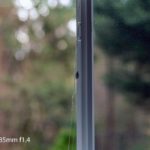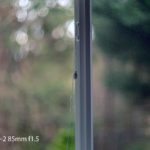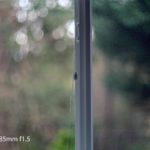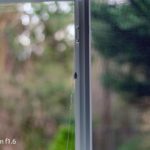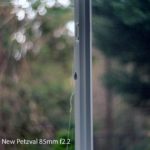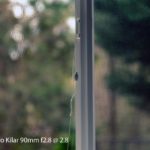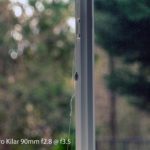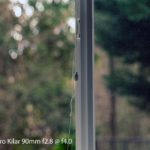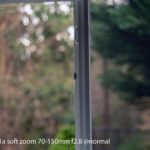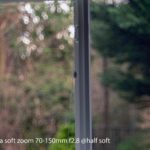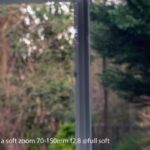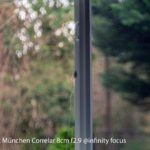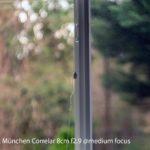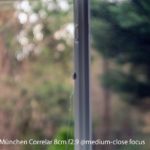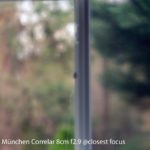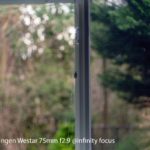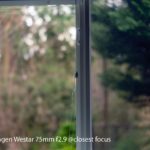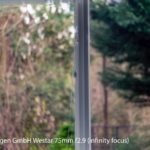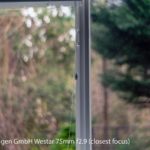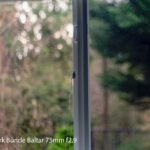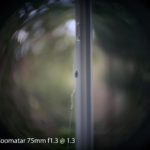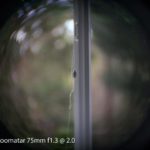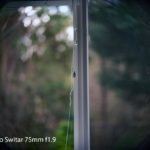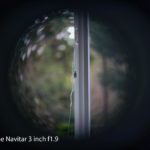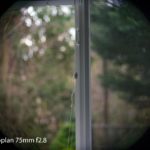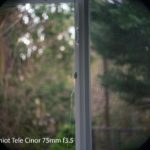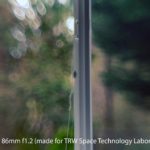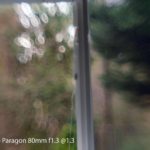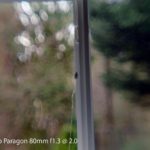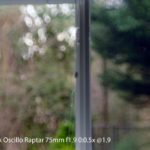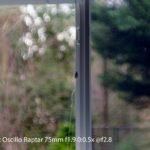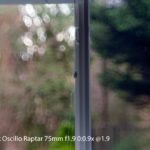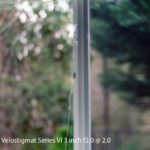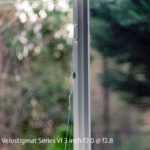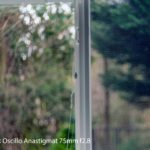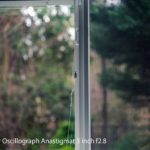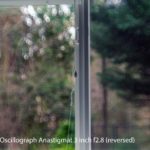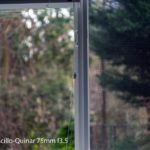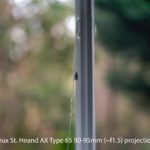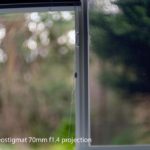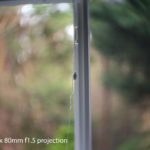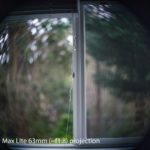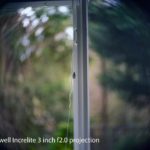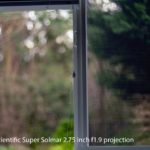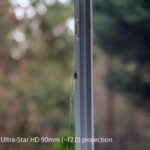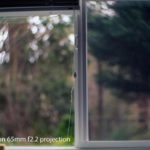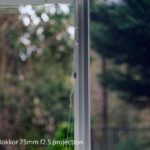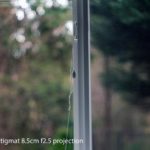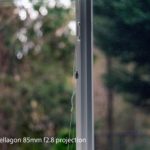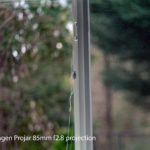I definitely have too many lenses, and in preparation for thinning the herd, I decided to do some direct comparison tests to see the differences between various lenses that I have. And in this category, I have a bunch. These focal lengths would be considered short telephoto lenses on “full frame”, and that is what I used for this comparison: a Sony A7RII with a standard 24x36mm sensor. However these are mostly not standard 35mm lenses. For the sake of convenience, I have divided them into four categories:
1) Standard photo lenses – for me this is any lens specifically made for a 35mm or medium format camera.
2) Cine lenses – I have a few C mount lenses of 75mm that were made for 16mm movie cameras. None covers full frame. I have shot on the full sensor and done some vignetting correction so that the full image circle can be clearly seen.
3) Special purpose lenses – I have a number of lenses made for recording oscilloscope traces, and one made for some 1:1 purpose for a space technology laboratory. I also have an unknown Wollensak lens that was probably also made for some scientific purpose, but no literature seems to exist to define its intended purpose
4) Projection lenses – these were made for projection of either 16mm or 35mm movies. Some cover full frame and others do not.
For this informal test, I chose an overcast day where changes in light would not be major (but it did change nevertheless). The camera was left in a fixed position recording the scene through my window of the yard, with the curtain sash in focus with the yard out of focus. The lenses themselves varied tremendously in terms of their rendering and even their color. A few are radioactive and have browning of the elements that I have found impossible to clear. And the light did change. I shot for highlights, but due to contrast differences the tonal balance varies considerably. I tried to equalize color and general tonal balance in post processing. I’ve added text to identify each lens and its settings, and the position of that text does vary a bit between images. This is not perfect, but should serve the general purpose of illustrating the difference between these lenses.
A note about bokeh – Because these lenses varied in focal length and aperture, both of which affect depth of field, I had to make a decision as to whether to try to keep the position constant or the subject size constant. For the sake of convenience as much as anything, I decided for the former. Another possibility would have been to have tried to keep the background defocus constant. Any aperture will produce a defocused background if one goes close enough to the subject, so any lens, even a slow one, will produce “good bokeh” if used under the right conditions. Arguably, for close work, a slower lens might actually be better, as it produces smaller circles of confusion, which will hold some character at closer distances, whereas a faster lens might just create complete blur. I have a few lenses of f6.3 and f6.8 that create beautiful bokeh at close distances. Of course as the focal length gets shorter, or one moves further away from the subject, a faster lens will create a more defocused background, and “bokeh”.
My own sense is that the distance I chose showed the actual rendering characteristics – the nicest bokeh – for these lenses at around f2.0. The slower lenses, for me, don’t show enough background defocus to accurately see the best “bokeh” rendering, whereas the faster lenses defocused it too much, so that it became mostly a characterless blur. But at least one can get an idea of how these lenses might perform under a variety of different conditions.
I generally shoot wide open, and I did so in these tests; however with certain lenses, notably the specialty ones, it is often good to close down one stop or so. Lenses with a lot of spherical aberration can produce very veiled images wide open, whereas stopping down a bit will increase contrast and sharpness without affecting the bokeh too much. So you will see that some lenses have been shot at a couple of different apertures.
Finally, there are a couple of lenses whose bokeh characteristics can be changed in other ways. One is a soft zoom with defocus control. And there are several lenses from old folding cameras that focused by changing the distance of the front element(s) only, while the back of the lens remained at a fixed distance from the focal plane. So I have focused the lenses at their closest and infinity distance, and then compensated using a helicoid. More on this later.
Below I will make some comments and explain further on the images as they appear in the gallery.
-some thoughts on these lenses-
1) Standard Camera lenses
Zenitar 85mm f1.4 – This is a new lens created in Russia by Zenit, I believe in an effort to create a fast portrait lens that is not as quirky as the old Helios 40-2. The lens shows good contrast and sharpness in the center, much better than with the Helios. The bokeh is quite smooth, but with some character. Altogether a nice but tame lens.
Helios 40-2 – A famous lens, an adaptation of the Zeiss Biotar 75mm f1.5. Mine is not an old lens, but a reissue, in Nikon mount. The lens is not particularly sharp, showing some glow around edges, but of course this “fault” is one of the reasons that the bokeh is interesting, the other being the barrel distortion and coma that creates the famous “swirly” bokeh. All in all, not a bad lens at all, considering that it is a classic double gauss design and quite fast to boot. I believe that the newer version has been tweaked slightly to improve contrast and sharpness as compared to the classic version, and the evidence is, perhaps in the next lens below.
Cyclop 85mm f1.5 – This lens has the same optical formula as the Helios 40-2, but has a different housing and lacks a diaphragm, being made for a night vision scope. At first glance the image produced by the Cyclop and the Helios seem identical, but in fact the Cyclop has a more “ni-sen” (Japanese for “two line”) bokeh, with brighter edges on the circles of confusion, creating a more etched look. This is, I believe, due to a higher amount of spherical distortion, which also manifests as more glow around the edges of sharp details. My guess is that this is the same as the older Helios 40-2 lenses, and that the newer ones have had the optical formula slightly tweaked in order to create better microcontrast, but which changes the bokeh. It may also just be a matter of manufacturing variability, but I do not have other examples to test. In any case this is one of my favorite lenses in this category of short tele, both for the swirl and the character of the bokeh.
Varo 75mm f1.6 – An interesting lens I ran across, made in Japan. It came with a C mount, but has the size and build of a 35mm lens. I removed the C mount and added an adapter to mount to Sony E, and it easily covers full frame with very little vignetting, but with a rather short flange distance, more or less like a 35mm rangefinder lens. It is not tremendously sharp on high magnification, but makes up for it with extremely good contrast and microcontrast. The bokeh is interesting: soft, but with an interesting quality that can be enhanced with a bit of post processing. Very recommendable if you find one.
Zenit Lomo New Petzval 85mm f2.2 – This lens was created several years ago by Zenit to be marketed as a new “classic” lens, with the typical look of the Petzval design: very sharp in the center, with extreme distortion near the edges and swirl. They have introduced also a 58mm Petzval design with variable bokeh and recently brought out a new version of the 85mm with a maximum aperture of f1.9 and added a helicoid rather than the faux-old rack and pinion focusing mechanism on this lens. All these lenses have a set of “Waterhouse Stops”–small plates with varying round openings that are slipped into the light path to change the aperture. The downsides of these are that they are small and fiddly and easy to lose, take time to change and leave a slot in the lens where dust can enter (though I have had no problem with that in this lens. And of course the stops are fixed and not variable. These disadvantages explain why the iris diaphragm became the standard way of varying the aperture, but on the plus side the Waterhouse stops are absolutely round, meaning that the bokeh circles are perfectly round, without the geometric shapes created by iris blades.
Optically the lens is very good, with excellent contrast and microcontrast, and reasonably sharp. It also has well defined bokeh, to give a very “etched” look. I have seen examples of the bokeh of the 58mm Petzval, and like the bokeh here much better.
Kilfitt Makro Kilar 90mm f2.8 – Kilfitt was a small lens company in Lichtenstein that produced some very unique lenses. The Makro Kilar 90mm is unique because of its double-ring bokeh, using one of – if not the first – aspherical element in a lens. Today, aspherical elements are reasonably common, but they are expensive and hard to manufacture out of glass, as the correct curve has to be custom ground. Modern asphericals are either made with CNC or are molded and then finished. Kilfitt’s answer to creating an aspherical element was to make it in two distinct curves with a step, which gives, more or less, the desired optical result, but creates a circle of confusion with two rings when shooting wide open. It is worth noting here that, in my understanding, there were two versions of this lens, and that the earlier model did not have this aspherical element and does not create the same double ring bokeh. I have heard this but have not been able to confirm it. If you are thinking of buying one of these lenses, though, it is good to check this out. Again in my understanding, the earlier version was silver and the later version black. I know that both black and silver types exist, but I do not know for a fact that black corresponds to two ring bokeh and silver to one ring bokeh.
Another unique feature is the ability to focus from infinity to 1:1 or 2:1 without internal focusing using a double of triple extending helicoid (depending on the model). Many, at least, came with a generic screw mount, to which one could add an adapter of choice–everything from C mount for a movie camera through various mounts for 35mm SLR systems, to MF mounts.
I’ve made a series of three images to show how the bokeh changes between f2.8 and f4. The second ring gets thinner and weaker as you stop down, disappearing completely by f4. This creates the ability to moderate the second ring, which is nice sometimes but also gets old as an effect very quickly, IMO.
Tamron 51a Fast Portrait Zoom with Soft Focus Feature 70-150mm f2.8 – Here is what Tamron had to say about this lens, which was manufactured in the 1970s:
“Tamron’s fast 70-150 F/2.8 constant aperture zoom lens was specifically designed for portrait photography, and was the first compact telephoto zoom lens ever produced by any manufacturer which featured a built-in softness control. This lens is extremely sharp at all focal lengths when not using the softness control since a total of six lens elements are used in the variator and compensator groups to reduce zoom dependent aberrations to their absolute minimum. Although the optical performance is somewhat optimized for 105mm (the ideal portrait focal length), this lens’s optical performance nevertheless is very good throughout the entire zoom range.
How does the softness control work? Simply press the SOFT ring button and then dial in any amount of softness adjustment from zero to three. The SOFT ring works by shifting the rear-most elements of the master lens group (the three lenses to the right of the aperture tick marks in the optical above diagram) to introduce spherical aberration plus small amounts of off-axis coma and off-axis astigmatism. Some may be wondering, “How accurate is the zero click stop position of the SOFT ring in order to prevent extremely slight softness from being introduced even though the SOFT ring is set to the zero position?” The answer is that Tamron machined the cam for the the three rear floating elements to produce zero softness effect until you turn the SOFT ring to approximately 1/4 of the way between the 0 to 1 marks on the SOFT ring.”
The lens is indeed quite sharp and has good contrast in normal mode. Again, I have made three images to show the effect that turning the soft ring has on bokeh. At normal, the lens already produces quite sharp bokeh, which increases as you turn the soft ring. At full soft, in the image, you will see that there is indeed a strong softening glow around sharp details, and the bright spot near the top of the window frame in the center has produced flare that spills into the dark part of the image. However, the rather unpleasant characteristics of the bokeh in the full soft image make for an interesting sharp bokeh when one focuses the lens closer. This is a very versatile lens for the bokeh enthusiast, with a combination of the zoom capability and the soft capability that offer many different looks.
Enna Werk München Correlar 8cm f2.9 – There were a number of German medium format “klappkamera” (folding camera) designs in the 1950s that had, as an option, a fast lens of 75 – 80mm and an aperture of f2.9. Why f2.9 instead of the standard stop of f2.8 I have no idea, but there it is. These lenses were all Cooke triplet designs, which give very good sharpness and very little vignetting. None of these cameras had rangefinders, so focusing distance had to be calculated either by estimation of by using an external rangefinder. Because the bellows were not adjustable, but locked in place when extended, focusing was accomplished with a small internal helicoid which moved the front element closer or further to the back elements. While this is cheap and simple, is does have the effect of changing the spacing of the elements and the performance of the lens.
This lens was removed not from a folding camera, but from a variant of the design called a “turret” camera, in which the lens is mounted on the end of a rigid tube which can be retracted and locked into position when not being used. When one wanted to take a picture, one rotated the lens, which then extended via a strong spring into shooting position. The Correlar was one of the options offered the Dacora Digna, along with a number of other lenses ranging from f8 to f2.9. There were two options, it appears, for the “fast” lens, either the Correlar or an Isco Westar 75mm f2.9 (more on that soon). All these lenses have bokeh that creates bright “bubbles” – circles of confusion with bright rings at the periphery – reminiscent of the famous Trioplan with its so-called “soap bubble” bokeh.
This Correlar has a unique characteristic, which is how much the bokeh changes depending on focusing distance set on the lens, meaning how far the front element is separated from the back two. Others of these lenses described later do not vary anywhere near as much. I’ve done four images showing the changes that happen when one focuses the lens from infinity to its close limit of approximately half a meter. (After setting focus on the lens, the lens is actually focused with the helicoid on which it is mounted to connect to the camera.) At infinity the lens it at its sharpest and most contrasty, with bright rings showing in out of focus highlights, but with some degree of color fringing. As the lens is focused closer, the rings spread and the bright rings get thinner with less fringing, until at full close, the bokeh is totally soft, with very low contrast and extreme veiling at sharp focus. This is a bit reminiscent of the “soft focus” control of the Tamron that I described above, but the final effect is much different, being that defocused elements are totally soft, as opposed to being more sharply defined. This lens is a lot of fun, and was, as far as I can tell, only available on the Dacora Digna camera.
Isco-Göttingen Westar 75mm f2.9 – This lens was another fast option on the Dacora Digna camera. It was also offered on the Franka Solida and the Balda Baldix, although on the latter it seemed to be a somewhat different lens (as described below). This lens is much as the Correlar, with perhaps slightly more delicate bokeh rings at infinity, but its character does not change nearly as much as the lens is focused using its own helicoid. I have made two images to show how it performs at infinity and at closest focus). In the latter case the bokeh shows some softening, like the Correlar, but maintains much better contrast and microcontrast.
Jsco-Göttingen GmbH Westar 75mm f2.9 – This version of the lens was fitted to the Balda Baldix, and is clearly a somewhat different optical design from the one fitted to the Franka and Dacora cameras. The look at infinity focus is quite different, more like the image of the Tamron zoom with full softness–less “spread” to the out of focus elements, with an additional bright spot in the center of the bokeh rings. At closest focus this one shows sharp bright rings, more like its brother at infinity focus. One nice thing with both Westars is that they show less color fringing in the bokeh rings than the Correlar.
Balda-Werk Bunde 75mm f2.9 – Another fast triplet from the Balda Baldix. At first I thought it might be the same lens at the Westar from the Digna and Franka (and different from the Westar on the Balda), and while the bokeh characteristics are similar to that Westar, the lens shows different distortion. This is shot at infinity. Unfortunately the lens focusing mechanism on this particular lens is frozen, so I cannot test it at close focus.
2) Cine lenses
Zoomar Zoomatar 75mm f1.3 – Another Kilfitt lens, but made after the Kilfitt company was acquired and moved to New York producing lenses, dropping the Kilfitt name. Hans Kilfitt invented both the macro and zoom lens, and named the latter “Zoomar,” and this is the name that his successor adopted for the company and its products. In addition to those two categories, Kilfitt also had a stunning line of very fast lenses, which included a 180mm f1.3 and 240mm f1.2 models. This 75mm f1.3 was intended solely for 16mm filmmakers, and has a C mount and very small image circle, barely covering APS-C when focused close. The lens has extreme swirl, very soft bokeh in the center, and while it is sharp, it suffers from severe halation, causing sharp elements to be veiled by a strong diffuse glow. Luckily the lens improves considerably by f2, without losing much of the character of its bokeh rendering.
Kern Macro Switar 75mm f1.9 – Kern was a Swiss company, and produced their beautiful lenses primarily for Swiss cameras: the 35mm Alpa and the 16mm and 8mm Bolex movie cameras. The 75mm f1.9 for C mount Bolex was made in two versions, one of them for close focusing and branded as a macro. I believe that it was the same optical design as the standard Switar 75mm but in a different housing. This lens is extremely sharp and contrasty in the center, with very little distortion until one gets to the edge of the image circle, with almost covers the APS-C frame focused close. The bokeh is very smooth, but still has some character, and is held in great esteem by those who like softer bokeh.
Elgeet Cine Navitar 3 inch f1.9 – This lens is every bit as sharp and contrasty in the center as the preceding Kern lens, but it has a much more limited image circle and more barrel distortion as you approach the edge of that circle. Bokeh is soft but with some character. This would be an excellent lens for MFT.
Meyer Trioplan 75mm f2.8 – This is the famous Cooke triplet Trioplan in a shorter version for C mount. The version I had at first seemed to have a very limited image circle, but I noticed a circular screw-in baffle at the rear of the lens, meant to limit light spill in the gate of a movie camera. Removing this, the lens now easily covers APS-C format. It is not particularly high contrast, but is reasonably sharp and has the characteristic “bubble bokeh” of the Trioplan. This version of the lens does have a bit of swirl at the edges which can be utilized in the image if one shoots full frame and crops to the minimum to fill the frame.
Som Berthiot Tele-Cinor 75mm f3.5 – This French lens also easily covers the APS-C frame, with very strong, well delineated bubbles, similar to the Trioplan but slightly smaller because of the aperture of f3.5. Notwithstanding their size, it gives very nice textured bokeh at close focusing distances, and has much more character, IMO, than its faster sibling, the 75mm f2.5 Tele-Cinor.
3) Special Purpose lenses
STL-Elgeet 86mm f1.2 (marked: made for TRW Space Technology Laboratories) – An interesting barrel lens, seemingly of symmetrical design, that was probably made either for recording some sort of instrument traces or perhaps as a collimating lens. It appears to be designed for 1:1 use. The lens is wildly radioactive, having at least two thoriated elements, which are, at this point, quite brown. I have tried to clear them as I have other yellowed lenses–exposing the lens to strong sunlight for days and days, with very little change. Nevertheless that lens has wild bokeh and strong negative field curvature. The lens is extremely sharp by with strong halation of focused elements wide open. It does become more manageable as one stops down, and retains its sharpness. It is not at all suitable for general photography at any aperture, but does give a nice effect at close focusing distances.
Ilex Oscillo-Paragon 80mm f1.3 0:0.5x – This lens was expressly designed to shoot faint oscilloscope traces at magnifications of half life size. Wide open it is somewhat similar to the STL-Elgeet above, with very strong bokeh rings with lots of color fringing, and halation wide open. As with all the Oscillo lenses I have tried, stopping down one stop highly increases contrast and microcontrast, improves halation and “glow”, without too much softening the bokeh. This lens too is very sharp in the center.
Wollensak Oscillo-Raptar 75mm f1.9 0:0.5x – Oscillo lenses are optimized for certain magnifications, and this Oscillo Raptar is made for half life size. There are two other Oscillo Raptars of this focal length that I know of: the most common is the 0:0.9x, made for near life size reproduction, and I have seen only one marked 0:0.85x. Before we go further, it is worth noting that Wollensak made different Oscillo lenses: there is the Oscillo Anastigmat, the Oscillo Amaton and the Oscillo Raptar. I do not have all, but it seems that the Anastigmat and the Amaton do not have the negative field curvature evident in the Raptar, and so are more suited to general shooting. However for us bokeh fanatics, shooting close, the Oscillo Raptars offer a unique rendering, with strong bokeh rings which get slightly elongated near the edges, instead of getting squeezed as happens with normal lenses. Just as a side note, Wollensak offered other Oscillo Raptars: there is a 88mm f1.4, a wild looking, huge lens with protruding front element, which unfortunately, because of its extremely short flange distance, cannot be used for anything but extreme closeups. There is also an 80mm f1.3 which is very rare.
I have both the 0:0.5x and 0:0.9x lenses and tried the former first. It shows smaller bokeh rings (though strong) than the latter both at maximum aperture and stopped down to f2.8. Both lenses are sharp, with halation around focused details wide open, getting much better already by f2.8
Wollensak Oscillo-Raptar 75mm f1.9 0:0.9x – Very similar to the preceding but with slightly different rendering. See above. As a note, if one reverses these lenses, it creates stronger rings with stronger negative field curvature, unfortunately it increases halation and decreases contrast, but one still can get interesting effect stopping down to around f3.5.
Wollensak Velostigmat Series VI 3 inch f2.0 – This is a mystery lens. There is no record anywhere of Wollensak making a “Series VI” lens, much less a 3 inch f2.0. I have seen only four examples of this lens online. They are uncoated, and were most probably made from the 1930s through the late 1940’s, and most probably for some scientific or industrial purpose. The lens, like other scientific Wollensaks, shows a lot of halation around details wide open, which decreases markedly one stop down. The lens is very sharp, notwithstanding that the microcontrast wide open is poor. Bokeh is highly defined, though with a lot of color fringing wide open (which is much reduced by f2.5 or so). Because it is uncoated, it flares quite a bit, but this can be helped a lot by shading the front element. Unlike the Oscillo Raptars, it does not show negative field curvature, and has virtually no vignetting. The background does not seem more defocused or the bokeh rings larger at f2.0 than f2.8, they just seem less sharply defined.
Wollensak Oscillo Anastigmat 75mm f2.8 – This is a slower version of the Oscillo Anastigmat 75mm f1.9, which I did not test. It shows basically the same pattern as the f2 Velostigmat described above, with basically similar bokeh. The lens is already quite contrasty wide open, and sharp, but of course the background is not as defocused or the bokeh rings as large. Interestingly, the background wide open at f2.8 seems considerably more in focus (and the bokeh rings smaller) than the Velostigmat at f2.8.
Dallmeyer Oscillograph Anastigmat 3 inch f2.8 – An oscillo lens from England, which is quite sharp wide open, but with a very different look than the Wollensak Oscillo Anastigmat: the circles of confusion – bokeh rings – are more delicate, with a sharper edge, and seem larger than the corresponding ones on the Wollensak lens. My preferred way to use this lens is to reverse it, in which case the circles become extremely well defined with a thin, bright edge, expanding towards the periphery, indicating negative field curvature.
Steinheil Oscillo Quinar 75mm f3.5 – An oscillo lens from Germany. Steinheil also makes an Oscillo Quinon lens, which I would someday like to see. This lens is quite sharp and with good contrast. Bokeh in the center is quite soft, becoming somewhat edgy towards the edges.
4) Projection lenses
P. Angenieux St. Heand AX Type 65 90-95mm – Angenieux made three types of projection lenses for 35mm film, the Type 65, 75 and 86. The lenses are of similar design – Petzval – in varying focal lengths, the difference being in the diameter and thus speed of the lens. The shortest focal length appears to be 85mm and the longest somewhere around 150mm. Each lens can vary the focal length a small amount (typically 5mm) by unscrewing the rear element group, thus chaning the spacing between front and rear element groups. This is clearly meant to “fine tune” the size of the projected image exactly to a given screen.
The shorter of these lenses show a fair amount of swirl at the edges, the longer focal lengths less so. The center is sharp, but rapidly gets poor as you move away from the center sweet spot. The lenses seem quite fast for their diameter, and I cannot explain that, except perhaps because there was very little light absorption by multiple elements. Bokeh is soft, with circles becoming cat’s eyes near the periphery.
Meopta Meostigmat 70mm f1.4 – Meopta makes some stunning projection optics. The Meostigmats are double gauss, which much less corner softness than Petzval designs, but then again, not nearly so well corrected in the corners as taking lenses. This lens has very good contrast and microcontrast, combined with fairly soft bokeh, but the shapes of the circles get quite interesting off center.
Angenieux 80mm f1.5 – This lens is extremely sharp in the center, but since it is designed for 16mm film and is a Petzval design, it loses sharpness rapidly off center. It has epic swirl, towards the edges, though there is a lot of chromatic aberration at the very border of the image circle, which is just shy of full frame.
Dallmeyer Max Lite 63mm – The Dallmeyer, too, has good center sharpness, another Petzval, with nice swirl, which will cover slightly more than APS-C. It has nicely defined bokeh, not too soft, but also not too hard. The Max Lite comes in various focal lengths, at least 2, 2.5, 3 and 4 inch versions. The longer ones have a slightly larger image circle, but with less swirl.
Bell & Howell Increlite 3 inch f2.0 – This lens is quite similar in rendering and characteristics to the Dallmeyer Max Lites. Why I ended up with such blue off center in this image I do not know. These tend to be rather inexpensive and are a good choice for cheap swirly bokeh.
General Scientific Super Solmar 2 3/4″ inch f1.9 – The Super Solmars may be rebranded Kollmorgen lenses, but in any case I quite like the look of this one, sharp, with well defined bokeh circles.
Isco-Optic Ultra-Star HD 90mm – This is a 35mm projection lens that easily covers full frame, and probably is of double gauss design. The f stop is not marked, but judging from the shutter speed, it must be around f2.0 The bokeh is extremely soft, contrast and sharpness good. Not really my taste, but these lenses tend to sell pretty cheaply, are easily adaptable and probably would be a good choice for portrait photographers.
Meyer Kinon 65mm f2.2 – The shorter Kinons are well known for their swirly bokeh. This one demonstrates that plus wide coverage which just fills full frame. Bokeh elements are also nicely defined.
Minolta P. Rokkor 75mm f2.5 – I guess the “P” stands for “projection”. This seems to be a lens for a slide projector, easily covering full frame. I have a special affection for this lens because while the bokeh circles are quite even, there is a very fine bright ring at the circumference, which gives the images a delicate etched look, less in-your-face than the Trioplan, but still nicely textured.
Aldis Anastigmat 8.5cm f2.8 – This Aldis lens is for a 35mm slide projector, I believe. It is another Cooke triplet, but not particularly sharp, and not with the highest contrast. I also have a 100mm f2.8 and had a 150mm f2.8 with a similar look. They are cheap and common and can give a nice “bubble bokeh” look, but not one of my favorites.
Staeble Stellagon 85mm f2.8 – Another of countless Cooke Triplet slide projector lenses, the Staeble is cheaply made in plastic mount, but actually outperforms the more solid Aldis above in terms of sharpness and contrast.
Isco-Göttingen V Projar 85mm f2.8 – Another slide projector lens in plastic mount, the Projar has similar characteristics to other lenses of this type, but is sharp and has nicely define triplet bokeh.
